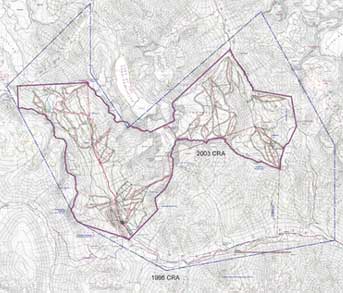|
||||||||||||
Progress to DateProgress Report
A large group of consultants has been participating in the project studies and reports, which range from on-going environmental monitoring and reviews to engineering and market analyses. A five volume report was presented in June 1995 by Pheidias Project Management Corp., the prime consultant, in compliance with CASP requirements for a Master Plan and in order to qualify for the transition into the Environmental Assessment Act review process. Following the 1995 report, additional studies were done, including the preparation of responses to the Project Specifications. This additional work covered the analysis of potential impacts on wildlife and wildlife habitat according to the proposed resort design; water quality and fisheries; waste disposal; geotechnical and engineering issues. Although the basic concept has not changed substantially, the ongoing work has refined and deepened the analysis, and provided a better design basis and a full response to the large body of the Project Specifications issued by the Environmental Assessment Office in 1998. The context of the Project Specifications was discussed with Provincial staff in order to finalize the responses in the Project Report. A Project Report consisting of 3,772 pages divided into thirteen volumes was formally accepted in February 2004 and a public input process was completed in June 2004. On October 14, 2004 the Environmental Assessment Office announced that the project received its Environmental Assessment Certificate. On July 12, 2007, the Master Plan was approved.
Public Consultation and ParticipationThe Proponent has undertaken a broad public participation process on three occasions — under CASP, CORE, the EA Act and the Master Plan approval process. There has been an on-going public debate on the issue of the rezoning process, fuelled by those who disagreed with the land use decision made by the East Kootenay CORE Table. The Directors of the Regional District of East Kootenay put an end to the controversy with a vote on August 7, 2009. Over the years, the Proponent has developed substantial public support and the final process has further documented that support. In the past twenty years, Pheidias and its consultants have been visiting the Jumbo Valley and the Columbia Valley communities on a regular basis, developing personal relationships and friendships, which they plan to continue to expand. Despite the concerted effort of special interest groups that have actively opposed the project since the CORE land use designation process, project opponents have not managed to significantly expand their base. The opposition's level of active support was recorded at roughly 1.4% of the population of the East Kootenay during the Environmental Assessment public process. It clearly indicated the support of the silent majority, as evidenced by local leaders. Pheidias was able to design and generate the project at the North end of the Columbia Valley, Kicking Horse Mountain Resort, for a different client, but utilizing a great deal of the same knowledge, experience, and policy input that generated the Jumbo Glacier Resort project proposal. It is a project that demonstrates the enthusiasm for new resorts and shows what communities with purpose can create. Significant Changes to the Master PlanJumbo Glacier Resort recently completed the most extensive environmental assessment program for any mountain resort in Western Canada. As a result of this process, a number of significant design changes have been introduced since the 1995 Draft Master Plan submission. The following changes are reflected in the current 2003 Master Plan Concept:
Environmental Assessment Act & Land Use DeterminationThe project was originally presented to the public with regard to the land use question in the summer of 1991 by B.C. Lands. An extensive public process was followed under the East Kootenay C.O.R.E. Table, concluding the land use decision with a favourable written report and a Government press release in April 1995. The project was then transitioned at the Master Plan stage into the new Environmental Assessment Act review process, and following additional extensive public consultations, the Environmental Assessment Office in May 1998 issued the final terms of reference as its legal Project Specifications to the Proponent. At the same time, the Province created the Mountain Resort Associations Act (now named the Resort Associations Act) and acting on a request by Pheidias, the Regional District of East Kootenay voted to support a request to create a Mountain Resort Municipality for Jumbo in 1996. The Project Specifications are the all important document that concluded a long and difficult period during which some special interests, represented both by sectors of government staff and local groups, created considerable controversy with a description of the project that was far from the truth. Project opponents succeeded in causing a decade of delays and unprecedented costs for studies, public processes, reviews, and a difficult bias in the Project Specifications and in the entire process. This not unusual opposition, and its lack of accountability, was supposed to derail the Government review process, and indeed it has continued to cause considerable delays, but the existence of a law such as the Environmental Assessment Act, gave comfort to the Proponent that the review process was moving towards a fair conclusion as it was designed to produce. The Proponent has been comforted during the long process by the support of the relevant Ministers and by the five most recent Premiers and Governments of British Columbia, who have repeatedly indicated that the project conforms to Government policy and that the review process will not be derailed. On October 14, 2004 the Environmental Assessment Office announced the granting of an Environmental Certificate for the Jumbo Glacier Resort project. Following approval of the Master Plan in 2007, the project is ready for the Master Development Agreement and start. « END OF SECTION »
|
||||||||||||
|
Project Outline •
Gallery •
Documents Copyright © 1996 - 2010, Glacier Resorts Ltd. All rights reserved. |
||||||||||||

